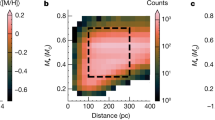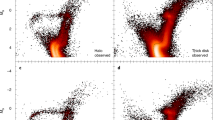Abstract
Stellar population and stellar kinematic studies provide unique but complementary insights into how galaxies build-up their stellar mass and angular momentum1,2,3. A galaxy’s mean stellar age reveals when stars were formed, but provides little constraint on how the galaxy’s mass was assembled. Resolved stellar dynamics4 trace the change in angular momentum due to mergers, but major mergers tend to obscure the effect of earlier interactions5. With the rise of large multi-object integral field spectroscopic surveys, such as SAMI6 and MaNGA7, and single-object integral field spectroscopic surveys (for example, ATLAS3D (ref. 8), CALIFA9, MASSIVE10), it is now feasible to connect a galaxy′s star formation and merger history on the same resolved physical scales, over a large range in galaxy mass, morphology and environment4,11,12. Using the SAMI Galaxy Survey, here we present a combined study of spatially resolved stellar kinematics and global stellar populations. We find a strong correlation of stellar population age with location in the (V/σ, \({\boldsymbol{\epsilon}}_{{\boldsymbol{e}}}\)) diagram that links the ratio of ordered rotation to random motions in a galaxy to its observed ellipticity. For the large majority of galaxies that are oblate rotating spheroids, we find that characteristic stellar age follows the intrinsic ellipticity of galaxies remarkably well.
This is a preview of subscription content, access via your institution
Access options
Access Nature and 54 other Nature Portfolio journals
Get Nature+, our best-value online-access subscription
$29.99 / 30 days
cancel any time
Subscribe to this journal
Receive 12 digital issues and online access to articles
$119.00 per year
only $9.92 per issue
Buy this article
- Purchase on Springer Link
- Instant access to full article PDF
Prices may be subject to local taxes which are calculated during checkout




Similar content being viewed by others
References
Tinsley, B. M. Evolution of the stars and gas in galaxies. Fundam. Cosm. Phys. 5, 287–388 (1980).
Davies, R. L., Efstathiou, G., Fall, S. M., Illingworth, G. & Schechter, P. L. The kinematic properties of faint elliptical galaxies. Astrophys. J. 266, 41–57 (1983).
Bender, R., Burstein, D. & Faber, S. M. Dynamically hot galaxies. II. Global stellar populations. Astrophys. J. 411, 153–169 (1993).
Cappellari, M. Structure and kinematics of early-type galaxies from integral field spectroscopy. Annu. Rev. Astron. Astrophys. 54, 597–665 (2016).
Naab, T. et al. The ATLAS3D project—XXV. Two-dimensional kinematic analysis of simulated galaxies and the cosmological origin of fast and slow rotators. Mon. Not. R. Astron. Soc. 444, 3357–3387 (2014).
Croom, S. M. et al. The Sydney–AAO Multi-object Integral field spectrograph. Mon. Not. R. Astron. Soc. 421, 872–893 (2012).
Bundy, K. et al. Overview of the SDSS-IV MaNGA Survey: mapping nearby galaxies at Apache Point Observatory. Astrophys. J. 798, 7 (2015).
Cappellari, M. et al. The ATLAS3D project—I. A volume-limited sample of 260 nearby early-type galaxies: science goals and selection criteria. Mon. Not. R. Astron. Soc. 413, 813–836 (2011).
Sánchez, S. F. et al. CALIFA, the Calar Alto Legacy Integral Field Area survey. I. Survey presentation. Astron. Astrophys. 538, A8 (2012).
Ma, C.-P. et al. The MASSIVE Survey. I. A volume-limited integral-field spectroscopic study of the most massive early-type galaxies within 108 Mpc. Astrophys. J. 795, 158 (2014).
van de Sande, J. et al. The SAMI Galaxy Survey: revisiting galaxy classification through high-order stellar kinematics. Astrophys. J. 835, 104 (2017).
Scott, N. et al. The SAMI Galaxy Survey: global stellar populations on the size–mass plane. Mon. Not. R. Astron. Soc. 472, 2833–2855 (2017).
Binney, J. Rotation and anisotropy of galaxies revisited. Mon. Not. R. Astron. Soc. 363, 937–942 (2005).
Cappellari, M. et al. The SAURON project—X. The orbital anisotropy of elliptical and lenticular galaxies: revisiting the (V/σ, ε) diagram with integral-field stellar kinematics. Mon. Not. R. Astron. Soc. 379, 418–444 (2007).
Cappellari, M. et al. The ATLAS3D project—XX. Mass-size and mass-σ distributions of early-type galaxies: bulge fraction drives kinematics, mass-to-light ratio, molecular gas fraction and stellar initial mass function. Mon. Not. R. Astron. Soc. 432, 1862–1893 (2013).
Lange, R. et al. Galaxy And Mass Assembly (GAMA): M ⋆–R e relations of z = 0 bulges, discs and spheroids. Mon. Not. R. Astron. Soc. 462, 1470–1500 (2016).
Emsellem, E. et al. The ATLAS3D project—III. A census of the stellar angular momentum within the effective radius of early-type galaxies: unveiling the distribution of fast and slow rotators. Mon. Not. R. Astron. Soc. 414, 888–912 (2011).
Foster, C. et al. The SAMI Galaxy Survey: the intrinsic shape of kinematically selected galaxies. Mon. Not. R. Astron. Soc. 472, 966–978 (2017).
Kormendy, J. & Kennicutt, R. C. Jr. Secular evolution and the formation of pseudobulges in disk galaxies. Annu. Rev. Astron. Astrophys. 42, 603–683 (2004).
Seidel, M. K. et al. The BaLROG project—I. Quantifying the influence of bars on the kinematics of nearby galaxies. Mon. Not. R. Astron. Soc. 451, 936–973 (2015).
van Dokkum, P. G. et al. Forming compact massive galaxies. Astrophys. J. 813, 23 (2015).
van der Wel, A. et al. 3D-HST+CANDELS: the evolution of the galaxy size–mass distribution since z = 3. Astrophys. J. 788, 28 (2014).
Newman, A. B., Belli, S. & Ellis, R. S. Discovery of a strongly lensed massive quiescent galaxy at z = 2.636: spatially resolved spectroscopy and indications of rotation. Astrophys. J. Lett. 813, L7 (2015).
Penoyre, Z., Moster, B. P., Sijacki, D. & Genel, S. The origin and evolution of fast and slow rotators in the Illustris simulation. Mon. Not. R. Astron. Soc. 468, 3883–3906 (2017).
Bland-Hawthorn, J. & Gerhard, O. The galaxy in context: structural, kinematic, and integrated properties. Annu. Rev. Astron. Astrophys. 54, 529–596 (2016).
Lee, Y. S. et al. Formation and evolution of the disk system of the Milky Way: [α/Fe] ratios and kinematics of the SEGUE G-dwarf sample. Astrophys. J. 738, 187 (2011).
Sharma, S. et al. Kinematic modeling of the Milky Way using the RAVE and GCS stellar surveys. Astrophys. J. 793, 51 (2014).
Schönrich, R. & Binney, J. Chemical evolution with radial mixing. Mon. Not. R. Astron. Soc. 396, 203–222 (2009).
Förster Schreiber, N. M. et al. The SINS Survey: SINFONI integral field spectroscopy of z ~ 2 star-forming galaxies. Astrophys. J. 706, 1364–1428 (2009).
Tacconi, L. J. et al. Phibss: molecular gas content and scaling relations in z ~ 1–3 massive, main-sequence star-forming galaxies. Astrophys. J. 768, 74 (2013).
Wisnioski, E. et al. The KMOS3D Survey: design, first results, and the evolution of galaxy kinematics from 0.7 < z < 2.7. Astrophys. J. 799, 209 (2015).
Bland-Hawthorn, J. et al. Hexabundles: imaging fiber arrays for low-light astronomical applications. Opt. Express 19, 2649 (2011).
Bryant, J. J., Bland-Hawthorn, J., Fogarty, L. M. R., Lawrence, J. S. & Croom, S. M. Focal ratio degradation in lightly fused hexabundles. Mon. Not. R. Astron. Soc. 438, 869–877 (2014).
Sharp, R. et al. Performance of AAOmega: the AAT multi-purpose fiber-fed spectrograph. Proc. 6269, 62690G (2006).
Bryant, J. J. et al. The SAMI Galaxy Survey: instrument specification and target selection. Mon. Not. R. Astron. Soc. 447, 2857–2879 (2015).
Driver, S. P. et al. Galaxy and Mass Assembly (GAMA): survey diagnostics and core data release. Mon. Not. R. Astron. Soc. 413, 971–995 (2011).
Owers, M. S. et al. The SAMI Galaxy Survey: the cluster redshift survey, target selection and cluster properties. Mon. Not. R. Astron. Soc. 468, 1824–1849 (2017).
Sharp, R. et al. The SAMI Galaxy Survey: cubism and covariance, putting round pegs into square holes. Mon. Not. R. Astron. Soc. 446, 1551–1566 (2015).
Allen, J. T. et al. The SAMI Galaxy Survey: early data release. Mon. Not. R. Astron. Soc. 446, 1567–1583 (2015).
Emsellem, E., Monnet, G. & Bacon, R. The multi-Gaussian expansion method: a tool for building realistic photometric and kinematical models of stellar systems I. The formalism. Astron. Astrophys. 285, 739–750 (1994).
Cappellari, M. Efficient multi-Gaussian expansion of galaxies. Mon. Not. R. Astron. Soc. 333, 400–410 (2002).
Scott, N. et al. The SAURON Project—XIV. No escape from V esc: a global and local parameter in early-type galaxy evolution. Mon. Not. R. Astron. Soc. 398, 1835–1857 (2009).
York, D. G. et al. The Sloan Digital Sky Survey: technical summary. Astron. J. 120, 1579–1587 (2000).
Shanks, T. et al. VST ATLAS first science results. Messenger 154, 38–40 (2013).
Cortese, L. et al. The SAMI Galaxy Survey: the link between angular momentum and optical morphology. Mon. Not. R. Astron. Soc. 463, 170–184 (2016).
Taylor, E. N. et al. Galaxy And Mass Assembly (GAMA): stellar mass estimates. Mon. Not. R. Astron. Soc. 418, 1587–1620 (2011).
Chabrier, G. Galactic stellar and substellar initial mass function. Publ. Astron. Soc. Pac. 115, 763–795 (2003).
Cappellari, M. & Emsellem, E. Parametric recovery of line-of-sight velocity distributions from absorption-line spectra of galaxies via penalized likelihood. Publ. Astron. Soc. Pac. 116, 138–147 (2004).
Sánchez-Blázquez, P. et al. Medium-resolution Isaac Newton Telescope library of empirical spectra. Mon. Not. R. Astron. Soc. 371, 703–718 (2006).
van de Sande, J. et al. The SAMI Galaxy Survey: revising the fraction of slow rotators in IFS galaxy surveys. Mon. Not. R. Astron. Soc. 472, 1272–1285 (2017).
Schiavon, R. P. Population synthesis in the blue. IV. Accurate model predictions for Lick indices and UBV colors in single stellar populations. Astrophys. J. Suppl. 171, 146–205 (2007).
McDermid, R. M. et al. The ATLAS3D Project—XXX. Star formation histories and stellar population scaling relations of early-type galaxies. Mon. Not. R. Astron. Soc. 448, 3484–3513 (2015).
Green, A. W. et al. The SAMI Galaxy Survey: Data Release One with emission-line physics value-added products. Mon. Not. R. Astron. Soc. 475, 716–734 (2018).
Acknowledgements
The SAMI Galaxy Survey is based on observations made at the Anglo-Australian Telescope. The Sydney–Australian Astronomical Observatory Multi-object Integral field spectrograph (SAMI) was developed jointly by the University of Sydney and the Australian Astronomical Observatory. The SAMI input catalogue is based on data taken from the Sloan Digital Sky Survey, the GAMA Survey and the VST ATLAS Survey. The SAMI Galaxy Survey is funded by the Australian Research Council Centre of Excellence for All-sky Astrophysics (CAASTRO), through project number CE110001020, and other participating institutions. The SAMI Galaxy Survey website is http://sami-survey.org/. Parts of this research were conducted by the Australian Research Council Centre of Excellence for All-sky Astrophysics in 3 Dimensions (ASTRO 3D), through project number CE170100013. J.v.d.S. is funded under Bland-Hawthorn′s Australian Research Council Laureate Fellowship (FL140100278). N.S. acknowledges support of a University of Sydney Postdoctoral Research Fellowship. S.B. acknowledges the funding support from the Australian Research Council through a Future Fellowship (FT140101166). M.S.O. acknowledges the funding support from the Australian Research Council through a Future Fellowship (FT140100255). J.v.d.S. and N.S. thank all SAMI team members for valuable discussions. A.M.M. is a Hubble Fellow.
Author information
Authors and Affiliations
Contributions
J.v.d.S. and N.S. led the interpretation. J.v.d.S. measured the stellar kinematic parameters from the SAMI Galaxy Survey spectra and wrote the text. N.S. measured the Lick indices from the spectra, and derived the stellar population ages. F.E. measured the structural parameters. All authors contributed to the analysis and interpretation of the data, and contributed to overall team operations, including target catalogue and observing preparation, instrument maintenance, observing at the telescope, writing data reduction and analysis software, managing various pieces of team infrastructure such as the website and data storage systems, and innumerable other tasks critical to the preparation and presentation of a large dataset presented here.
Corresponding author
Ethics declarations
Competing interests
The authors declare no competing interests.
Additional information
Publisher’s note: Springer Nature remains neutral with regard to jurisdictional claims in published maps and institutional affiliations.
Supplementary information
Supplementary Information
Supplementary Figure 1–5
Rights and permissions
About this article
Cite this article
van de Sande, J., Scott, N., Bland-Hawthorn, J. et al. A relation between the characteristic stellar ages of galaxies and their intrinsic shapes. Nat Astron 2, 483–488 (2018). https://doi.org/10.1038/s41550-018-0436-x
Received:
Accepted:
Published:
Issue Date:
DOI: https://doi.org/10.1038/s41550-018-0436-x
This article is cited by
-
Galactic shape and age go hand in hand
Nature Astronomy (2018)



